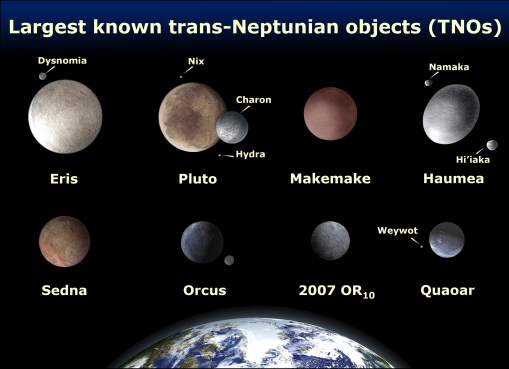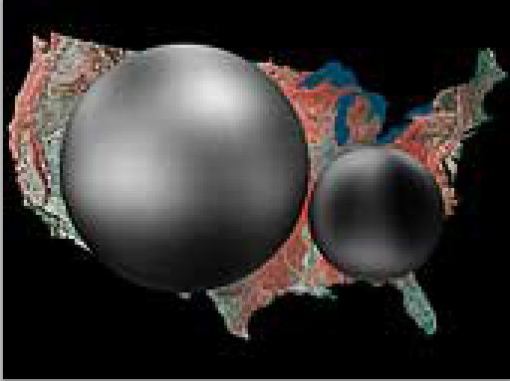Rhea and Epimetheus are two of Saturn’s dozens of moons — Rhea is the larger body visible here. The Cassini orbiter which took this photograph arrived at Saturn in 2004, and is expected to continue operating until at least 2017.
the solar system
July 8, 2010
June 14, 2010
If you’re on the road this summer – specifically, if you’re up in Aroostook County, in northern Maine – check out this immense scale model of the solar system. The model – with 1 mile equal to 1 AU – runs 40 miles along Route 1 between the University of Maine at Presque Isle and the end of I-95. I’m not saying go out of your way to check it out – but should you happen to be in the neighborhood…here’s Venus at the Budget Traveler Motor Inn.
At forty miles from the sun, Pluto is a one-inch ball at the Houlton Information Center. This, more than any other model I’ve seen, really conveys how big space is — and how empty.
May 18, 2010
Alan Boyle, author of The Case for Pluto, makes an eloquent and moving argument for the importance of thinking of Pluto — and its trans-Neptunian brethren — as full-fledged worlds in their own right. Conceiving of them as worthy of the culturally-weighted term “planet” makes a difference in how we see our own position in the solar system:
 “Never again can Pluto be the ninth planet. Or the littlest planet. Or the most distant planet. But does that make Pluto a non-planet? No way. Even before Pluto was discovered, the solar system was divided into two classes of planets: the rocky worlds like Earth, and the gas giants beyond. Pluto has pointed the way to the solar system’s third great class of planets, no less important than the other two…
“Never again can Pluto be the ninth planet. Or the littlest planet. Or the most distant planet. But does that make Pluto a non-planet? No way. Even before Pluto was discovered, the solar system was divided into two classes of planets: the rocky worlds like Earth, and the gas giants beyond. Pluto has pointed the way to the solar system’s third great class of planets, no less important than the other two…
“Alan Stern, the principal investigator for the New Horizons mission to Pluto, says there could be many thousands of icy worlds out on the solar system’s rim–and hundreds of them could well qualify as dwarf planets. Over the long run, that will almost certainly change the way we look at our own place in the universe. And what’s so bad about that?
“‘The original view, until 10 or 15 years ago, was that we had four Earth-like terrestrial planets, four gas giants, and the misfit Pluto. But the new view is four terrestrial planets, four gas giants, and hundreds of Plutos,'” Stern says. “‘It’s jarring, because Pluto’s no longer the misfit. It’s the Earth-like planets that are the misfits.'”
May 17, 2010
TNO? TMI? WTF?
Posted by plutovian under Clyde Tombaugh, Is it a planet?, planetkillers, the solar system1 Comment
Trans-Neptunian Objects isn’t a term used much any longer. “Dwarf planets” is the preferred term, if you’re being PC. (“Little planets”, if you’re being really PC.)
 Anyway, these are the biggies. They’re all out beyond Neptune’s orbit. They’re all large enough to be kinda planetlike in some ways — they’re in hydrostatic equilibrium (meaning they get mostly round and stay mostly round). They’re not themselves satellites. But they aren’t large enough to have “cleared their neighboring region of planetesimals,” i.e., to have slurped up all other orbiting bodies unto themselves. Which means, according to the International Astronomical Union’s Resolution 5A of 2006, they aren’t planets.
Anyway, these are the biggies. They’re all out beyond Neptune’s orbit. They’re all large enough to be kinda planetlike in some ways — they’re in hydrostatic equilibrium (meaning they get mostly round and stay mostly round). They’re not themselves satellites. But they aren’t large enough to have “cleared their neighboring region of planetesimals,” i.e., to have slurped up all other orbiting bodies unto themselves. Which means, according to the International Astronomical Union’s Resolution 5A of 2006, they aren’t planets.
And what would Clyde Tombaugh have thought? My impression of Clyde in his later life is of a man at peace with himself. Every picture I’ve seen of him shows him beaming, and surely he was much beloved. Though he defended Pluto’s planetary status when it first was questioned in the 1990s, I believe he also recognized his discovery of Pluto as being something of a happy accident. And today, I can imagine him arguing that we welcome the planetary status of such substantial bodies as Eris, Haumea, Makemake, Orcus, Quaoar, and so on. The universe had made room for him in such an unlikely fashion, after all – I believe he’d have wanted us to return the favor. So on Clyde’s behalf, let the IAU know we want Pluto back!
(Thanks once again to the great Laurel Kornfeld for her ongoing, informed contributions to this discussion – and for filling in some details on the IAU kerfuffle.)
May 13, 2010
How big is Pluto exactly?
Posted by plutovian under Is it a planet?, the solar systemLeave a Comment
May 13, 2010
I didn’t know until very recently about the kooky theories surrounding Planet X — not in 1930, I mean, but right now, today. While I won’t link to any of the real loonies directly, a quick read of the Wikipedia entry on the Niburu collision should give you a sense of what kinds of lunacy people are capable of committing to. (In sum, the belief involves a NASA conspiracy to cover up the existence of a giant 10th planet on a collision course with Earth.) The most strenuous advocates of this belief appear to be either deeply delusional — I mean, mentally ill — or outright charlatans. Charlatanism is entertaining, but untreated mental illness ain’t.
 Happily, the forces of good are hard at work. The excellent Phil Plait, of Bad Astronomy fame, is on the case against the Planet X conspiracists. Of course, demonstrating logical fallacies, misconceptions, misunderstandings, and the like to a group of conspiracy theorists is sort of like describing soccer to your cats: they might appear to be listening, but their behavior never seems to change.
Happily, the forces of good are hard at work. The excellent Phil Plait, of Bad Astronomy fame, is on the case against the Planet X conspiracists. Of course, demonstrating logical fallacies, misconceptions, misunderstandings, and the like to a group of conspiracy theorists is sort of like describing soccer to your cats: they might appear to be listening, but their behavior never seems to change.
But someone’s got to stand up to the kooks. One more hurrah for the scientists among us! And as Phil Plait says:
March 25, 2010
While I can’t get the video to embed here, this link shows the rotating surface of Pluto as seen through the Hubble in 1994. This is the work of Alan Stern of the Southwest Research Institute and Marc Buie of Lowell Observatory.
from the link:
“Some of the variations across Pluto’s surface may be caused by topographic features such as basins, or fresh impact craters. However, most of the surface features unveiled by Hubble, including the prominent northern polar cap, are likely produced by the complex distribution of frosts that migrate across Pluto’s surface with its orbital and seasonal cycles and chemical byproducts deposited out of Pluto’s nitrogen-methane atmosphere. The picture was taken in blue light when Pluto was at a distance of 3 billion miles from Earth.”
March 12, 2010
I’ve never tried, but hardy souls with medium-sized telescopes have managed it. You need a 5-inch reflecting telescope (or larger), dark skies, and a little patience. Check out these charts for help in determining Pluto’s current position, and look here for a description of a recent occultation. 
Pluto was at its recent brightest in 1989, at perihelion – its closest passage to the sun. It will grow dimmer until the year 2113, when it will reach aphelion.
Whatever it is, Pluto is a long, long way from here.
February 13, 2010
Galileo was the first to see Neptune, making a note of it in 1613 — but because it appeared nearly stationary in the sky, he didn’t recognize it as a planet. It would be another 233 years before Johann Gottleib Galle rediscovered Neptune, directed by calculations made by Urbain Le Verrier, who had observed irregularities in Uranus’ orbit that could best be accounted for by the existence of another, undiscovered body beyond that planet’s orbit. Galle’s discovery of Neptune in 1846 — less than a degree from the position suggested by Le Verrier’s calculations — would have a profound influence on the search for Planet X some decades later. 
The great strangeness of the discovery of Pluto is this: Percival Lowell’s calculations of the irregularities in Uranus’ orbit suggested that a roughly Neptune-sized planet remained to be discovered at the edge of the solar system, beyond Neptune itself (a “Trans-Neptunian Object”). And in 1930, Pluto was indeed discovered very close to the position Lowell predicted for it.
But Pluto is far too small to have introduced any significant wobble into any object’s orbit. So why did Lowell’s math send him right to Pluto’s position?
As it turns out, Pluto’s location was nothing but an amazing, impossible coincidence. Still, it’s hard not to imagine some kind of mystical explanation, as though Lowell had managed to divine some truth about the Solar System simply by sitting in the high desert air for decades.
And as it happens, there aren’t any significant wobbles in Uranus’ orbit; the observations Lowell was using were minutely faulty.
Well, it is a mystery.





